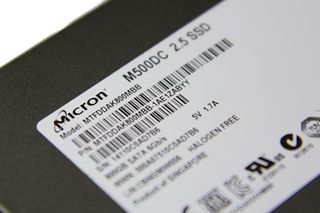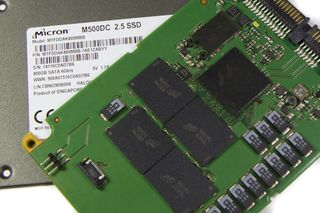Micron M500DC 800 GB SSD Review: Cloud And Web 2.0 Storage
Building on the desktop-oriented M500, Micron is announcing its enterprise-focused M500DC. We got a chance to run the 800 GB model through an updated test suite to gauge whether this Marvell-powered SSD keeps up with the best-known enterprise solutions.
Creating A New Mid-Range Enterprise Market
Over the last year, the enterprise-oriented offerings from Micron have been a mixed bag. While we really liked its PCIe-based accelerators, the P400m couldn't quite stand up to its competition. That was especially disappointing considering the company's expansive NAND portfolio and firmware expertise. Christopher and I have always said that SSD vendors with NAND production capabilities should always come out on top. With the M500DC, Micron lives up to that expectation with a product that offers good performance at what we expect will be attractive pricing.

When it comes to comparing SSDs, you already know that there are many variables to consider: price, performance, endurance, value-adds, and more. Micron's M500DC should make you think a little harder about each if you're in the position to outfit a big organization with solid-state storage. It doesn't fit into some of the more traditional markets carved out in recent months. Outside of SanDisk's Optimus line, there simply aren't many drives that match its specs. And the M500DC doesn't lead in many categories, either. But where it does shine, it bests an impressive list of relatively comparable products.
Let's start with the bad. In straight read performance, Micron trails the pack. Demonstrating lower sequential and random read throughput, the M500DC is not suited for read-heavy applications. Instead, you'd be better off tapping Micron's M500 or Intel's SSD DC S3500.
Write performance favors the M500DC more, and it gives pricier SSDs a run for their money. Even though the 800 GB model's specs trail the 480 and 240 GB versions, the drive we're reviewing still outclasses most entry-level enterprise-oriented SSDs.
Enterprise workloads, so long as they involve writes, show Micron's latest excelling. The M500DC posts incredibly high numbers, particularly in our test designed to replicate the behavior of a database.
Write endurance has the M500DC in the middle of a distinguished pack. It's much better than the read-focused entry-level drives, but naturally trails the eMLC- and SLC-based offerings. Further, endurance is a tricky spec to evaluate. It used to be that endurance was closely related to the type of NAND used. But Micron (and SanDisk) extends the life of its flash well beyond the stuff most consumers encounter. They're consequently able to offer better $/TBW, which is what consumers are, presumably, asking for.

So, it all comes back to what enterprise customers want in an SSD. Micron believes it knows, and it tailors the M500DC's performance to match. For mixed-workload environments, the product of those efforts performs as well as anything on the market. And for where we expect its price to land, the M500DC should end up in a class by itself.
Stay on the Cutting Edge
Join the experts who read Tom's Hardware for the inside track on enthusiast PC tech news — and have for over 25 years. We'll send breaking news and in-depth reviews of CPUs, GPUs, AI, maker hardware and more straight to your inbox.
Current page: Creating A New Mid-Range Enterprise Market
Prev Page Results: Power Consumption-
ParrLeyne Good article/review!Reply
Only one _small_ problem. According to the Micron product page (http://www.micron.com/products/solid-state-storage/enterprise-sata-ssd/m500dc-enterprise-sata-ssd) the M500DC is a SATA device, not SAS! -
tripleX The author obviously does not understand the subject matter. SAS lumped in with SATA? read-centric SSD isnt meant for read workloads? etc. numerous errors, too many to list.Reply -
tripleX Author does not understand what "corner case" is. corner case testing? are you doing lab validation work?Reply -
drewriley In SSD testing, it is common to call the mix in testing between read/write and random/sequential as '4 corner' or 'corner case' testing. And yes, this is lab verification work, that is kind of the point of the review. Also, SAS and SATA do compete for applications. The point was to put different product that had similar specifications against one another.Reply -
tripleX Reply13279486 said:In SSD testing, it is common to call the mix in testing between read/write and random/sequential as '4 corner' or 'corner case' testing. And yes, this is lab verification work, that is kind of the point of the review. Also, SAS and SATA do compete for applications. The point was to put different product that had similar specifications against one another.
The fact you are claiming this is anything even remotely near lab validation exposes your tremendous lack of knowledge on the subject.
No one refers to 4-corner testing as corner case testing. One link to a reputable site that does so? Instead of arguing an indefensible point you should be attempting to learn exactly what corner case means. Most would have had the good sense to do that before posting.
SAS v SATA is like Formula 1 compared to Go-Karts. Another example of your lack of understanding. SAS is meant for users who require certain features, and the price demands that users are aware of those features. They do not compete against each other, they are two entirely different classes of hardware.
-
tripleX The fact you are claiming this is anything even remotely near lab validation exposes your tremendous lack of knowledge on the subject.Reply
No one refers to 4-corner testing as corner case testing. One link to a reputable site that does so? Instead of arguing an indefensible point you should be attempting to learn exactly what corner case means. Most would have had the good sense to do that before posting.
SAS v SATA is like Formula 1 compared to Go-Karts. Another example of your lack of understanding. SAS is meant for users who require certain features, and the price demands that users are aware of those features. They do not compete against each other, they are two entirely different classes of hardware.
Most Popular

